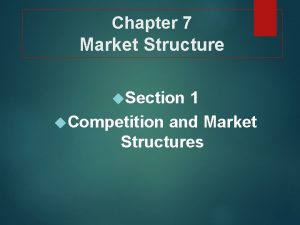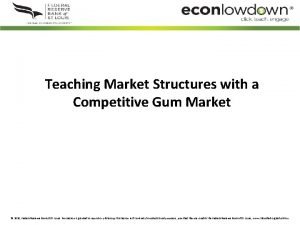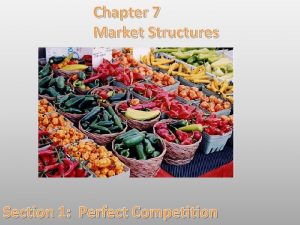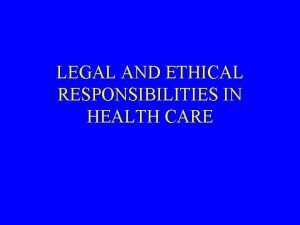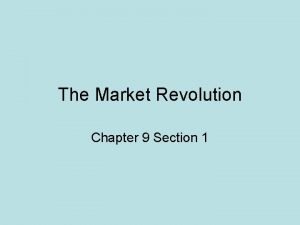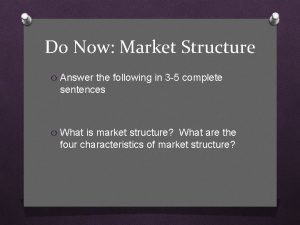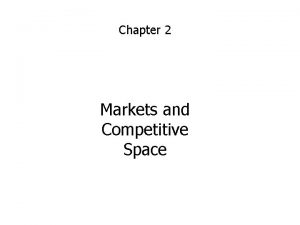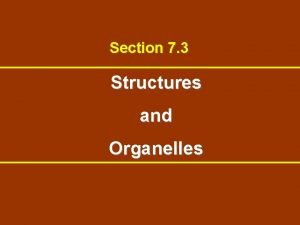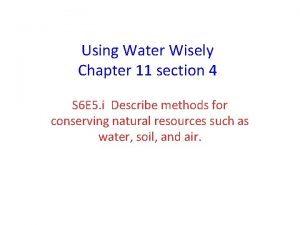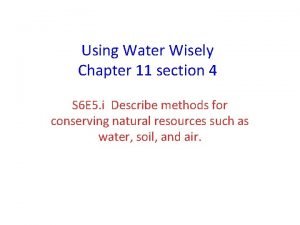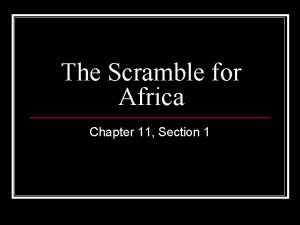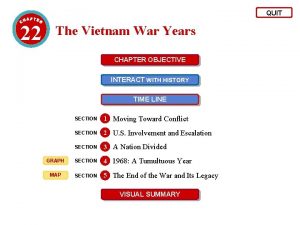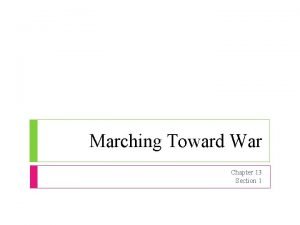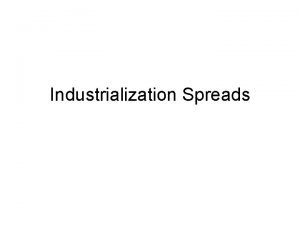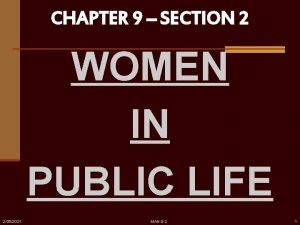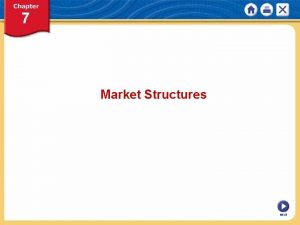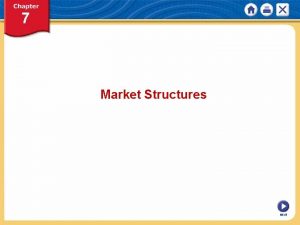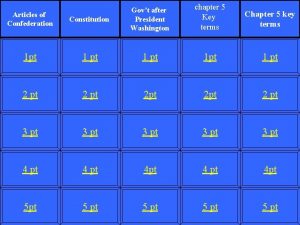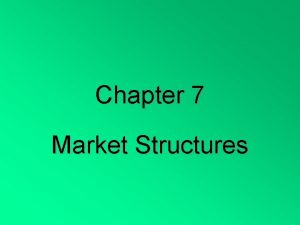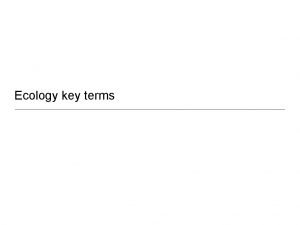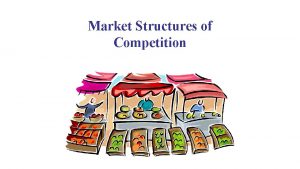Chapter 7 Market Structures Section 1 Key Terms























































- Slides: 55

Chapter 7: Market Structures Section 1

Key Terms • perfect competition: a market structure in which a large number of firms all produce the same product and no single seller controls supply or prices • commodity: a product that is considered the same no matter who produces or sells it • barrier to entry: any factor that makes it difficult for a new firm to enter a market Chapter 7, Opener Copyright © Pearson Education, Inc. Slide 9

Key Terms, cont. • imperfect competition: a market structure that fails to meet the conditions of perfect competition • start-up costs: the expenses a new business must pay before it can begin to produce and sell goods Chapter 7, Opener Copyright © Pearson Education, Inc. Slide 10

Introduction • What are the characteristics of perfect competition? – Many buyers and sellers – Identical products – Informed buyers and sellers – Free market entry and exit Chapter 7, Opener Copyright © Pearson Education, Inc. Slide 11

Perfect Competition • The simplest market structure is perfect competition, also called pure competition. • A perfectly competitive market: – Has a large number of firms – Has firms that produce the same product – Assumes the market is in equilibrium – Assumes that firms sell the same product at the same price Chapter 7, Opener Copyright © Pearson Education, Inc. Slide 12

Conditions of Perfect Competition • There are only a few perfectly competitive markets in today’s world because these markets must meet four strict conditions: – Many buyers and sellers participating in the market – Sellers offering identical products – Buyers and sellers that are well-informed about products – Sellers are able to enter and exit the market freely Chapter 7, Opener Copyright © Pearson Education, Inc. Slide 13

Conditions, cont. • Many buyers and sellers – Perfectly competitive markets must have many buyers and sellers. • No one person or firm can be so powerful as to influence the total market quantity or market price. Chapter 7, Opener Copyright © Pearson Education, Inc. Slide 14

Conditions, cont. • Identical Products – There is no difference in the products sold in a perfectly competitive market. • These commodities include things like low-grade gasoline, notebook paper, and sugar. Chapter 7, Opener Copyright © Pearson Education, Inc. Slide 15

Conditions, cont. • Informed buyers and sellers – Under conditions of perfect competition, the market provides the buyer with full information about the product features and its price. • Both buyers and sellers have full disclosure about the product. • Free market entry and exit – It is very easy for sellers to enter and exit in a perfectly competitive market. • Usually they enter when a product is very popular and exit when the demand for that product decreases. Chapter 7, Opener Copyright © Pearson Education, Inc. Slide 16

What is Perfect Competition? Chapter 7, Opener Copyright © Pearson Education, Inc. Slide 17

Barriers to Entry • Checkpoint: Which barrier to entry can be overcome by education or vocational training? – Imperfect competition can come about through barriers to entry. – Common barriers include: • Start-up costs: When start-up costs are high it is more difficult for new firms to enter the market. Therefore, markets with high start-up costs are less likely to be perfectly competitive. • Technology: Markets that require a high degree of technical knowledge can be difficult to enter into without preparation and study. Chapter 7, Opener Copyright © Pearson Education, Inc. Slide 18

Barriers to Entry, cont. • Landscaping presents no technical challenges and startup costs are low. However, an auto repair shop requires advanced technical skills and the equipment needed to run the shop makes start-up costs another significant barrier to entry. Chapter 7, Opener Copyright © Pearson Education, Inc. Slide 19

Prices • Perfectly competitive markets are efficient and competition keeps both prices and production costs low. – In a perfectly competitive market prices correctly represent the opportunity costs of each product. – They are also the lowest sustainable prices possible. Chapter 7, Opener Copyright © Pearson Education, Inc. Slide 20

Chapter 7: Market Structures Section 2

Key Terms • monopoly: a market in which a single seller dominates • economies of scale: factors that cause a producer’s average cost per unit to fall as output rises • natural monopoly: a market that runs most efficiently when one large firm supplies all of the output • government monopoly: a monopoly created by the government Chapter 7, Opener Copyright © Pearson Education, Inc. Slide 25

Key Terms, cont. • patent: a license that gives the inventor of a new product the exclusive right to sell it for a specific period of time • franchise: a contract that gives a single firm the right to sell its goods within an exclusive market • license: a government-issued right to operate a business • price discrimination: the division of consumers into groups based on how much they will pay for a good • market power: the ability of a company to control prices and total market output Chapter 7, Opener Copyright © Pearson Education, Inc. Slide 26

Introduction • What are the characteristics of a monopoly? – A single seller – Many barriers to entry for new firms – No variety of goods – Complete control over price Chapter 7, Opener Copyright © Pearson Education, Inc. Slide 27

Describing Monopoly • Checkpoint: What are three characteristics of a monopoly? – A single seller in a market – Many barriers to entry for new firms – Supplying a unique product with no close substitute • Since they have the market cornered for a particular good or service, monopolies can change high prices and the quantity of goods is lower than it would be in a competitive market. Chapter 7, Opener Copyright © Pearson Education, Inc. Slide 28

Economies of Scale • Different market conditions can create different types of economies. • Some monopolies enjoy what is known as economies of scale - characteristics that cause a producer’s average cost to drop as production rises. – Why do production costs fall as output increases in an economy of scale? Chapter 7, Opener Copyright © Pearson Education, Inc. Slide 29

Natural Monopolies • Another type of monopoly is a natural monopoly. • Public water is an example of a natural monopoly. – If water were a part of the competitive market, different companies would spend large sums of money to dig reservoirs - more land water would be used than necessary. It would be very inefficient. Chapter 7, Opener Copyright © Pearson Education, Inc. Slide 30

Natural Monopolies, cont. • Technology can sometimes destroy a natural monopoly. – A new innovation can cut fixed costs and make small companies as efficient as one large firm. Chapter 7, Opener Copyright © Pearson Education, Inc. Slide 31

Government Monopolies • Checkpoint: What government actions can lead to the creation of monopolies? – Issuing a patent - gives a company exclusive rights to sell a new good or service for a particular period of time. – Granting a franchise - gives a single firm the right to sell its goods within an exclusive market – Issuing a license - allows firms to operate a business, especially where scarce resources are involved – Restricting the number of firms in a market Chapter 7, Opener Copyright © Pearson Education, Inc. Slide 32

The Monopolist’s Dilemma • Monopolists look at the big picture and try to maximize profits, which usually means they produce fewer goods at higher prices. • The monopolist’s dilemma can be viewed in terms of demand. – The law of demand states that buyers will demand more of a good at lower prices. – BUT the more a monopolist produces, the less they will receive in profits. Chapter 7, Opener Copyright © Pearson Education, Inc. Slide 33

Falling Marginal Revenue • One of the key differences between monopolies and perfect competition is that in a perfectly competitive market, marginal revenue is always the same as price, and each firm receives the same price no matter how much it produces. • Neither assumption is true in a monopoly. Chapter 7, Opener Copyright © Pearson Education, Inc. Slide 34

Setting a Price • The graph to the right shows how prices are set in a monopoly. • The marginal revenue curve is in blue, the demand curve is in red, and the marginal cost in green. – How does point c show the benefits to consumers in a perfectly competitive market? Chapter 7, Opener Copyright © Pearson Education, Inc. Slide 35

Price Discrimination • In many cases, the monopolist charges the same price to all customers. • But in some instances, the monopolist may be able to charge different prices to different groups. This is known as price discrimination. – Price discrimination is based on the idea that each customer has a maximum price that he or she will pay for a good. Chapter 7, Opener Copyright © Pearson Education, Inc. Slide 36

Targeted Discounts • There are many targeted discounts available to particular groups, including: – Discounted airline fairs – Senior citizen and student discounts – Children fly or stay free promotions Chapter 7, Opener Copyright © Pearson Education, Inc. Slide 37

Limits of Price Discrimination • Checkpoint: What three conditions must a market meet in order for price discrimination to work? – Firms must have some market power – Customers must be divided into distinct groups – Buyers must not be in a position in which they can easily resell the good or service • Most forms of price discrimination are legal, but some firms use price discrimination to drive other firms out of business, which is illegal. Chapter 7, Opener Copyright © Pearson Education, Inc. Slide 38

Chapter 7: Market Structures Section 3

Key Terms • monopolistic competition: a market structure in which many companies sell products that are similar but not identical • differentiation: making a product different from other, similar products • nonprice competition: a way to attract customers through style, service, or location, but not a lower price • oligopoly: a market structure in which a few large firms dominate a market Chapter 7, Opener Copyright © Pearson Education, Inc. Slide 42

Key Terms, cont. • price war: a series of competitive price cuts that lowers the market price below the cost of production • collusion: an illegal agreement among firms to divide the market, set prices, or limit production • price fixing: an agreement among firms to charge one price for the same good • cartel: a formal organization of producers that agree to coordinate prices and production Chapter 7, Opener Copyright © Pearson Education, Inc. Slide 43

Introduction • What are the characteristics of monopolistic competition and oligopoly? – Monopolistic Competition • • Many firms in the market Some variety of goods Minimal barriers to entry Little control over prices – Oligopoly • • Chapter 7, Opener Few firms in the market Some variety of goods Many barriers to entry Some control over prices Copyright © Pearson Education, Inc. Slide 44

Monopolistic Competition • In monopolistic competition, many companies compete in an open market to sell similar, but not identical, products. • Common examples or monopolistically competitive firms are: – Bagel shops – Gas stations – Retail stores Chapter 7, Opener The market for jeans is monopolistically competitive because jeans can vary by size, color, style, and designer. Copyright © Pearson Education, Inc. Slide 45

Monopolistic Competition Conditions • Many Firms – Low start-up costs allow many firms to enter the market. • Few barriers to entry – It is easy for new firms to enter the market. • Little control over price – If a firm raises their prices too high, consumers will go elsewhere to buy the product. • Differentiated products – Allows a firm to profit from the differences between their product and a competitor’s product. Chapter 7, Opener Copyright © Pearson Education, Inc. Slide 46

Nonprice Competition • In a monopolistically competitive market, nonprice competition plays a big role. Chapter 7, Opener Copyright © Pearson Education, Inc. Slide 47

Prices • Prices, output, and profits under monopolistically competitive market structures look very similar to those under perfectly competitive market structures. • Prices – Under monopolistic competition prices are higher but their demand curves are more elastic because customers can choose among many substitutes. Chapter 7, Opener Copyright © Pearson Education, Inc. Slide 48

Output and Profits • Output – As a result of the relative elasticity in monopolistically competitive firms, the total output falls somewhere between that of a monopoly and that of perfect competition. • Profits – Monopolistically competitive firms earn just enough to cover all of their costs. – They can earn profits in the short run, but too many competitors make this hard to maintain in the long run. • Checkpoint: What keeps monopolistically competitive firms from making high profits? Chapter 7, Opener Copyright © Pearson Education, Inc. Slide 49

Oligopoly • Oligopoly describes a market dominated by a few, profitable firms. – Why are high barriers to entry an important part of oligopoly? – Why are there only a few firms in an oligopoly? Chapter 7, Opener Copyright © Pearson Education, Inc. Slide 50

Barriers to Entry • Barriers to entry in an oligopoly can be technological or they can be created by a system of government licenses or patents. – Economies of scale can also lead to an oligopoly. Chapter 7, Opener Copyright © Pearson Education, Inc. Slide 51

Cooperation, Collusion, and Cartels • There are three practices that concern government regarding oligopolies. – Price leadership: This can lead to price wars when companies in an oligopoly disagree – Collusion: This leads to price fixing and is illegal in the United States – Cartels: By coordinating prices and production, cartels offer its members strong incentives to produce more than its quota, which leads to falling prices. Chapter 7, Opener Copyright © Pearson Education, Inc. Slide 52

Chapter 7, Opener Copyright © Pearson Education, Inc. Slide 53

Chapter 7: Market Structures Section 4

Key Terms • predatory pricing: selling a product below cost for a short period of time to drive competitors out of the market • antitrust laws: laws that encourage competition in the marketplace • trust: an illegal grouping of companies that discourages competition • merger: when two or more companies join to form a single firm • deregulation: the removal of some government controls over a market Chapter 7, Opener Copyright © Pearson Education, Inc. Slide 57

Introduction • When does the government regulate competition? – Sometimes the government takes steps to promote competition because markets with more competition have lower prices. – The government does this through: • Antitrust laws • Approving or not approving mergers • Deregulation Chapter 7, Opener Copyright © Pearson Education, Inc. Slide 58

Market Power • Monopolies and oligopolies are viewed by many as being bad for the consumer and the economy. – Public outrage with powerful trusts in the late 1800 s led Congress to pass antitrust regulation. Chapter 7, Opener Copyright © Pearson Education, Inc. Slide 59

Government and Competition • The federal government has policies, known as antitrust laws, to keep firms from gaining too much market power. – The Federal Trade Commission and the Department of Justice’s Antitrust Division watches firms to make sure they don’t unfairly force out competitors. Chapter 7, Opener Copyright © Pearson Education, Inc. Slide 60

History of Antitrust Policy • Despite the antitrust laws, companies have used many strategies to gain control over their markets. – Over the past century, the federal government has acted to promote competition in American industry. Chapter 7, Opener Copyright © Pearson Education, Inc. Slide 61

Regulating Microsoft • The government can regulate companies that try to get around antitrust laws. – In 1997 the Department of Justice accused Microsoft of using its near-monopoly over the operating system market to try to take control of the browser market. – A judge ruled against Microsoft. The case was finally settled in 2002. Microsoft could not force computer manufacturers to provide only Microsoftware on new computers. Chapter 7, Opener Copyright © Pearson Education, Inc. Slide 62

Blocking Mergers • The government has the power to prevent the rise of monopolies by blocking mergers. • The government also checks in on past mergers to make sure that they do not lead to unfair market control. – The government tries to predict the effects of a merger before approving it. Chapter 7, Opener Copyright © Pearson Education, Inc. Slide 63

Corporate Mergers • Some mergers can benefit consumers. – Corporate mergers will lower average prices, which leads to: • Lower prices • More reliable products and services • More efficient industry Chapter 7, Opener Copyright © Pearson Education, Inc. Slide 64

Deregulation • Some government regulation was seen to reduce competition, which led to the deregulation of some industries. • Over several years, the government deregulated: – – – Chapter 7, Opener Airlines Trucking Banking Natural gas Railroad Television broadcasting Copyright © Pearson Education, Inc. Slide 65

Judging Deregulation • Checkpoint: How does deregulation encourage competition in a market? – Usually many new firms entered deregulated industries right away. – Deregulation often weeds out weaker players in the long term but it can be hard on workers in the short term. Chapter 7, Opener Copyright © Pearson Education, Inc. Slide 66

Deregulating the Airlines • When airlines were first deregulated, many new airlines entered the market, but some eventually failed. • Competition increased among the remaining airlines and prices went down. Yet many busy airports had and still have one dominant airline. Chapter 7, Opener Copyright © Pearson Education, Inc. Slide 67

Deregulating the Airlines, cont. • The 9/11 attacks caused many people to stop flying and revenues fell as costs for security, insurance, and fuel rose. – Today the future of the airline industry is still uncertain. Chapter 7, Opener Copyright © Pearson Education, Inc. Slide 68

Review • Now that you have learned about when the government steps in and regulates competition, go back and answer the Chapter Essential Question. – How does competition affect your choices? Chapter 7, Opener Copyright © Pearson Education, Inc. Slide 69
 Lesson 1 competition and market structures
Lesson 1 competition and market structures Chapter 5 section 3 the minor parties
Chapter 5 section 3 the minor parties Teaching market structures with a competitive gum market
Teaching market structures with a competitive gum market Concept mapping chapter 10 meiosis 1 and meiosis 2
Concept mapping chapter 10 meiosis 1 and meiosis 2 Market leader follower challenger nicher
Market leader follower challenger nicher Positioning segmentation targeting
Positioning segmentation targeting Chapter 7 market structures vocabulary
Chapter 7 market structures vocabulary Barriers to entry for perfect competition
Barriers to entry for perfect competition Chapter 7 section 3 structures and organelles
Chapter 7 section 3 structures and organelles Chapter 7 section 3 structures and organelles
Chapter 7 section 3 structures and organelles Homologous structures and analogous structures
Homologous structures and analogous structures Chapter 11 nutrition
Chapter 11 nutrition Chapter 11 nutrition and diets key terms
Chapter 11 nutrition and diets key terms Legal and ethical responsibilities
Legal and ethical responsibilities Test chapter 3 careers in health care
Test chapter 3 careers in health care Polynomial degrees and terms
Polynomial degrees and terms What are like terms
What are like terms The business model canvas
The business model canvas Key partners key activities key resources
Key partners key activities key resources Chapter 9 section 1 labor market trends
Chapter 9 section 1 labor market trends The market revolution chapter 9 section 1
The market revolution chapter 9 section 1 Chapter 6 section 2 changes in market equilibrium
Chapter 6 section 2 changes in market equilibrium Market structure poster
Market structure poster Pure competition
Pure competition Market structure venn diagram
Market structure venn diagram Goods definition
Goods definition Product-market boundaries and structure
Product-market boundaries and structure Pure competition market structure
Pure competition market structure Section 3 structures and organelles
Section 3 structures and organelles Chapter 15 section 1 types of waves answers
Chapter 15 section 1 types of waves answers Chapter 11 section 4 using water wisely answer key
Chapter 11 section 4 using water wisely answer key Using water wisely
Using water wisely Chapter 11 section 1 the scramble for africa answer key
Chapter 11 section 1 the scramble for africa answer key The rise of christianity chapter 6 section 3
The rise of christianity chapter 6 section 3 Chapter 6 section 3 the enlightenment spreads
Chapter 6 section 3 the enlightenment spreads Chapter 22 section 3 the enlightenment spreads answer key
Chapter 22 section 3 the enlightenment spreads answer key Chapter 11 section 2 stream and river deposits answer key
Chapter 11 section 2 stream and river deposits answer key Chapter 21 section 1 landforms and resources
Chapter 21 section 1 landforms and resources Chapter 18 review chemical equilibrium section 2 answer key
Chapter 18 review chemical equilibrium section 2 answer key Chapter 14 section 1 revolutions in russia
Chapter 14 section 1 revolutions in russia Chapter 22 section 4 1968: a tumultuous year answer key
Chapter 22 section 4 1968: a tumultuous year answer key Chapter 11 section 3 motion and force answer key
Chapter 11 section 3 motion and force answer key Motion section 1 describing motion
Motion section 1 describing motion Chemistry chapter 9 stoichiometry
Chemistry chapter 9 stoichiometry Marching toward war
Marching toward war Chapter 9 section 2 manifest destiny answer key
Chapter 9 section 2 manifest destiny answer key Landforms and resources section 1
Landforms and resources section 1 Industrialization spreads
Industrialization spreads Chapter 9 section 3 industrialization spreads answer key
Chapter 9 section 3 industrialization spreads answer key Chapter 31 section 3 fascism rises in europe answer key
Chapter 31 section 3 fascism rises in europe answer key Chapter 13 section 2 europe plunges into war
Chapter 13 section 2 europe plunges into war Chapter 17 section 3 domains and kingdoms answer key
Chapter 17 section 3 domains and kingdoms answer key Chapter 5 section 1 measuring motion answer key
Chapter 5 section 1 measuring motion answer key Chapter 17 cold war superpowers face off
Chapter 17 cold war superpowers face off Chapter 18 review chemical equilibrium section 3 answer key
Chapter 18 review chemical equilibrium section 3 answer key Chapter 17 section 2 women in public life
Chapter 17 section 2 women in public life
